A GUIDE TO GOOGLE UNIFIED PRICING RULES:
HOW TO BUILD YOUR TARGET CPM AND PRICE FLOOR STRATEGY [+ TEMPLATE]
Get a PDF copy of the guide along with the Google Sheets Templates for managing your strategy using the form below, and scroll down to read the entire guide right on this page.
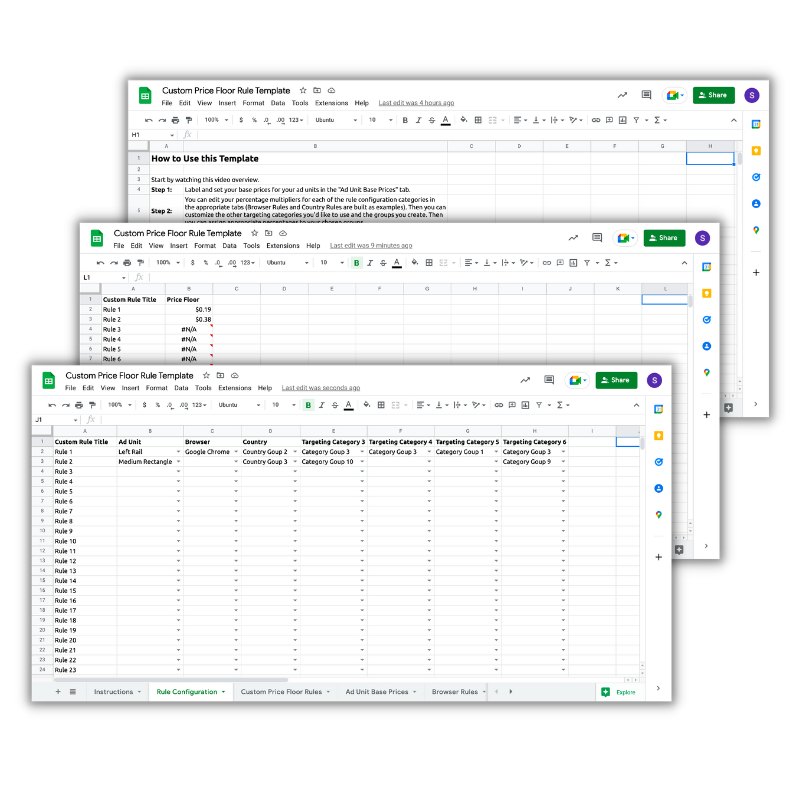
Get your copy of the templates and a PDF copy of the guide:
We'll email you downloadable PDF versions of the guide and the templates, and you can read them later.
INTRODUCTION
This guide is meant to help you understand how to build a comprehensive target CPM or price floor strategy. The strategic guidance in this article is platform agnostic, however as we get more tactical in executing the strategy deeper in the article, we will be showing how to manage this strategy specifically in Google Ad Manager (GAM).
DOWNLOAD THE FREE TOOL
Download our Custom Price Floor Rule Template to use as you move through this article.
Table of Contents
Target CPM and Price Floor Basics
What is a price floor?
In digital advertising, a price floor is a setting that defines the lowest fixed CPM rate that you are willing to accept for an ad impression. It will block the sale of impressions for any amount lower than the fixed value after reviewing bids from the open auction.
What is a unified pricing rule?
Unified pricing rules is the name used in Google Ad Manager for the tools used to manage price floors.
What is a target CPM?
The Target CPM setting in Google Ad Manager is an alternative way to set a price floor. Instead of setting a fixed floor, the Target CPM setting will allow flexibility around your Target CPM to help maximize fill while keeping the majority of inventory sold above the Target CPM.
The relationship between fill rate and CPM plays an important role in your overall ad revenue. The age-old laws of supply and demand essentially dictate that the less there is of something (the lower the supply), the greater the demand will be for that thing.
Raising your floor price will lower your fill rate and reduce the supply of your inventory, making it more valuable. This drives higher CPMs. The balance comes in finding the perfect price floor that maximizes the combination of fill rate and CPM.
As your CPM increases, your fill rate will decrease. If your floor price is too high, you won't sell enough impressions. If your price floor is too low, you'll sell a lot of impressions, but your average CPM won't be very large. Ultimately it creates a relationship like the one shown in the graphic below for your ad revenue.
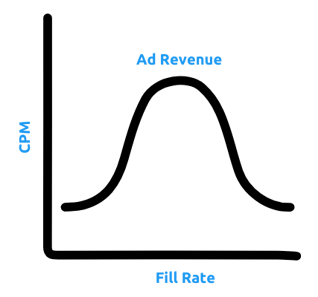
There will be a sweet spot right where your total ad revenue is maximized. The goal of a price flooring strategy is to find that sweet spot for many different combinations of circumstances, maximizing total ad revenue in each set of circumstances.
One-off Price Rules vs. a Comprehensive Price Floor Strategy
All too often, publishers look at price floor rules as individual items, single rules added on an ad hoc basis. Approaching your strategy like this can leave your rules disjointed and your ad revenue suffering.
Instead, we suggest publishers build a comprehensive price flooring strategy that combines different targeting criteria to create a set of rules that govern the strategy of your price floors in concert.
Similar to calling plays in sports, you don’t have each player on the team following a different strategy. The whole team knows the play, and each player is meant to take part in a larger strategy, effectively making the play much stronger.
Your target CPM and price floor strategy should be no different. Now let us show you how to do it!
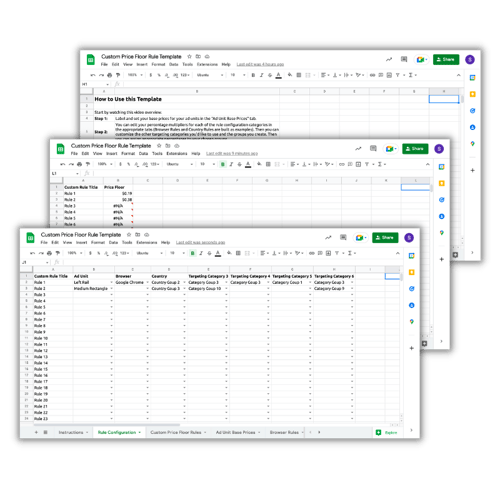
Price Floor Targeting Recommendations
There are tons of different targeting criteria you can use to build price rules. So many, in fact, it becomes very overwhelming very quickly.
Our ad yield management team has spent years tinkering with price floor strategies, running tests, and generally becoming the leading experts in what works. We’ve tapped them to put together a list of “starter” best practices when it comes to choosing targeting criteria for your price floor rules.
Set Separate Pricing Parameters for Each of Your Ad Units
Each different kind of ad unit you offer will have its own intrinsic value. Units that have higher viewability and engagement will be worth more. So the first step in setting your custom price floor strategy is to set unique floor prices for each ad unit you have.
Larger ad units, or those with higher viewability, can typically command higher price floors than smaller display units. Sticky or adhesive ad units that maximize viewability should also have higher price floors than traditional display units. Interactive units and video units should have significantly higher price floors than display units.
Ultimately, looking at your past CPM performance and average CPMs for your individual ad units should make it pretty clear how your base prices should be set in relation to each other.
Important Targeting Parameters
To get started, our team recommends focusing on making custom rules for the targeting criteria that create the most variance CPMs.
- Device Type: The type of device a user is on will have a factor in determining how valuable the impression is. Typically on mobile devices and tablets, inventory is simply not as valuable as that on desktop.
- Country: The country where you are serving your ads will also have a major effect on the CPM you are capable of earning when serving impressions. Breaking up countries by standard tiers is a good starting point.
- Browser: The browser a user is using to visit your website can also affect your ultimate CPMs. Because Firefox and Safari don’t collect cookies, visits are typically less valuable than those from Chrome users.
- Day of Week: Different days of the week tend to perform better than others for average CPMs. Typically we find across our network that Fridays and weekends perform better than other days of the week, but this may be different for your site.
- Hour of Day: You can even go so far as to make specific price floor rules for time of day. In general we’ve found that CPMs tend to be higher in the middle of night, spike in the morning, and go down in the afternoon.
Google Ad Manager does have quite a bit more targeting options available, but we’d recommend starting with these groups to begin with.
A Note About Google Ad Manager Unified Pricing Rule Limits
Even the most premium account with Google Ad Manager 360 limits you to 200 custom unified pricing rules.
As you can see just from the starting recommendations, if you have just 5 ad units and use the starting targeting criteria listed, you will already be far exceeding the boundaries on the number of rules you can create.
Say you use each one of the 5 different criteria categories listed above, and say, for argument’s sake, that you had just 5 different choices for each of those criteria (i.e. for Browser you have Google Chrome, Safari, Firefox, Android, and Microsoft Edge).
This means that if you multiply out all of the different variations of rules you can create, you’d be looking at:
5 Ad Units X 5 Device Variations X 5 Country Variations X 5 Browser Variations X 5 Day of Week Variations X 5 Hour of Day Variations = 15,625 Individual Rules
Now, in reality, there are far more than 5 variations for many of these rules, and you may well have a lot more than 5 different ad units, but I think we’ve already proven our point.
There is simply no way to capture as many individual rules as you could possibly create with the limited number of rules you have.
This leaves you with 2 choices:
- Get really creative (which we will help with shortly).
- Find a partner that has built technology that can manage an infinite number of price rules, and has AI and machine learning technology that automatically customizes them to create the best performance for your website. Good thing we know someone who’s got technology like that.
Changing the Way You Look at Price Rules
In order to both build a comprehensive price floor strategy, and to find ways to get around those pesky rule limits, you need to change the way you’re looking at price rules.
We mentioned that they can’t be thought of as individual rules but instead as a set of interconnected rules that govern a comprehensive price floor strategy. Today, we’re going to show you how to do that.
Ad Unit Base Prices + Targeting Criteria Levers
The way to build this strategy is to think of your ad units first. You’ll set base floor prices for each ad unit that govern their “starting point”.
Then, you’ll view the targeting criteria as levers that adjust the ad unit’s base price. Each of the different options for targeting criteria should apply a different percentage increase or decrease from the base price.
From there you can simply multiply all of the criteria levers with base ad unit price to come up with a custom price floor rule for a specific situation.
Walking Through an Example
Let’s demonstrate with an example (keep in mind that the numbers used are entirely random and simply used to demonstrate the concept):
We’ll set “Ad Unit A” with a base price floor of $0.50 to begin based on past performance.
Now we’ll use 2 levers in our example: Browser and Country.
Let’s say our options for browsers are: Google Chrome, Safari, Firefox, Android, and Microsoft Edge. We’ll assign a percentage that will increase or decrease the price floor from the base price based on each factor:
- Google Chrome: 110%
- Safari: 75%
- Firefox: 75%
- Android: 85%
- Microsoft Edge: 90%
Because we have hundreds of options for countries, we’ll have to break the countries into groups in order to build our strategy. For argument’s sake we’ll break them into continents, and assign percentage which will increase or decrease the price floor from the base price:
- Countries in Asia: 75%
- Countries in Africa: 80%
- Countries in North America: 100%
- Countries in South America: 50%
- Countries in Antarctica: 2%
- Countries in Europe: 87%
- Australia: 90%
Now, to create a custom price rule for Ad Unit A being shown on a Safari Browser in a country in Africa, we’d multiply to get our custom price floor rule:
$0.50 X 75% X 80% = $0.30
Now, if we are managing this in spreadsheet form, we also can easily build custom price rules for 35 different combinations of all of these factors.
All of the sudden, we are looking at a comprehensive strategy that can be maintained centrally. Say you want to change the percentage increase or decrease allocated to Countries in South America because you are seeing ads performing well in that geo; now all you have to do is adjust the percentage assigned to it, and all of your corresponding rules that include Countries in South America as a targeting criteria can be updated simultaneously.
Grouping Targeting Criteria
Now let’s cover how you can creatively try to work around some of the limitations on the number of custom rules you can create.
You’ve already seen this strategy in action in the example above, where we grouped countries together rather than setting percentages for each individual country. To lessen the sheer number of variations there are, you can group like criteria options together.
For instance, on the Browser example above, you’ll notice that both Safari and Firefox were set to 75%. If we view these two browsers as equivalent, we can combine them into a single criteria in order to reduce our total number of criteria options.
The breakdown would then look like this:
- Google Chrome: 110%
- Safari & Firefox: 75%
- Android: 85%
- Microsoft Edge: 90%
This now brings down our total number of rule variations we can create from just the combination of the two criteria of Browser and Country from 35 down to 28.
As often as you can, you will need to look for opportunities to group criteria options that are close enough together in order to maximize what you can get from your, at most, 200 allowed price rules.
A Template for Building Your Price Floor Strategy
Now that we’ve covered the concept of how base prices and targeting levers work together, you can begin to think about how you want to execute your own price floor strategy.
We’ve created a template that will help you manage your very own custom price floor strategy in a single location, and automatically combine your chosen levers with your ad unit base prices in order to build your strategy.
Set Ad Unit Base Prices
Once you download the template, you’ll start on the “Ad Unit Base Prices” Tab.
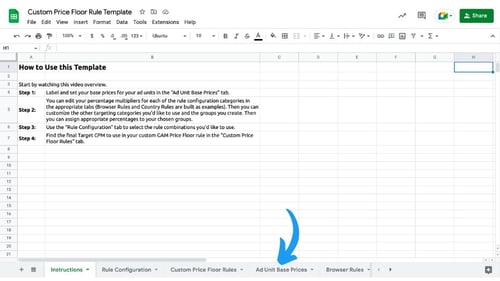
On this tab you’ll list all of your ad units by name and set your starting or base prices for each.
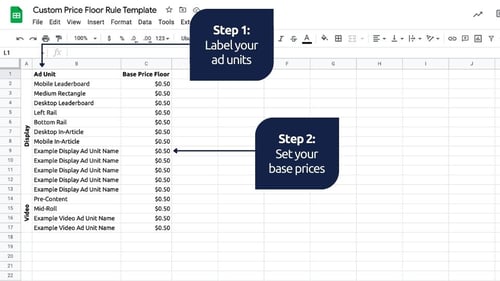
Right now the template currently supports 16 different ad units. You can simply name the ones you don’t want to use with placeholder names (but don’t delete the cells as this has the potential to break the logic in the template).
Manage Targeting Criteria
Now we’ll start setting the percentages for our targeting criteria levers. The template is pre-built with the ability to combine up to 6 different targeting criteria. You’ll be able to manage your rule percentages for each of the 6 categories in separate tabs.
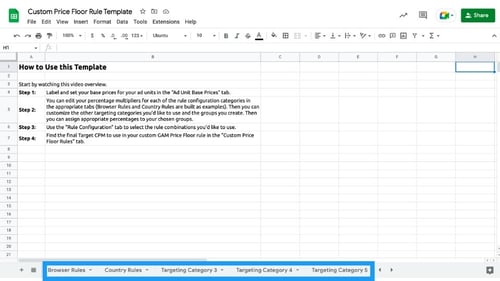
Because Browser and Country are some of the most common factors used in price floor rules, we’ve included them by default.
Set Your Browser Rules
We’ll start setting our targeting criteria rules with Browser. Navigate to the “Browser Rules” tab.
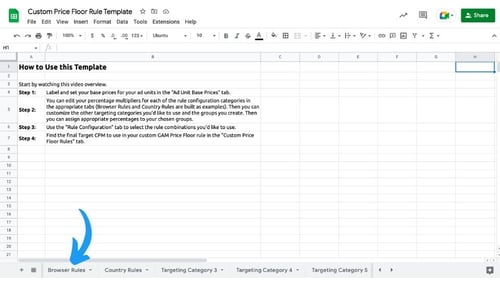
On this tab you’ll be able to set your desired percentages (more than 100% will increase the CPM from your base price, less than 100% will decrease) based on the value of each of the standard browsers.
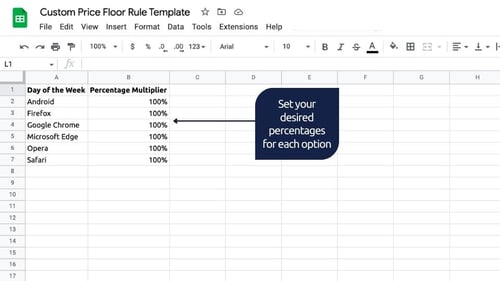
Set Your Country Rules
Next, we’ll set our rules for countries. Navigate to the “Country Rules” tab.
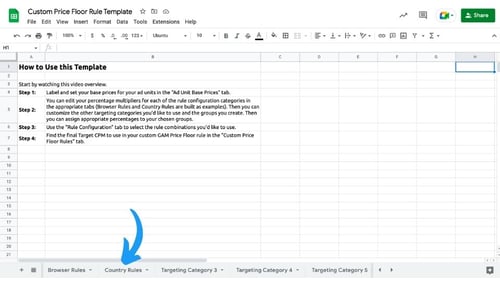
Here you will start by breaking up countries into groups. You can break them up however makes the most sense to you, often people start by breaking them into standard tier groups.
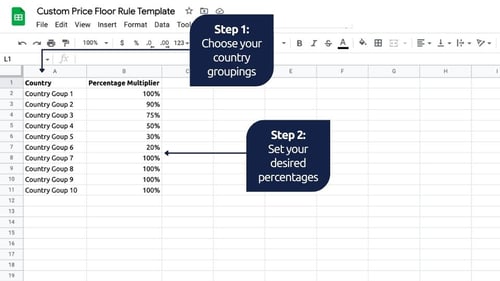
The template has space for up to 10 different country groups. If you have less than 10 groups (which you likely should), you can simply name the ones you don’t want to use with placeholder names (but don’t delete the cells as this has the potential to break the logic in the template).
Set Your Custom Rules
Now it is time to have some fun. The rest of the targeting criteria options are up to you!
Navigate to the appropriate tab for the custom rule you want to build. There is space in the template for up to 4 additional targeting criteria rules in addition to Browser and Country. The tabs are titled “Targeting Criteria 4” through “Targeting Criteria 6”.
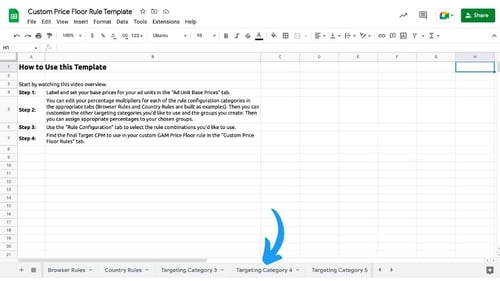
In each of these tabs, you can title the targeting criteria however you’d like.
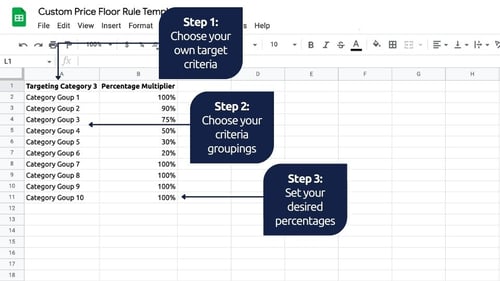
Now you’ll want to decide if you are going to use the criteria “as-is” or break it into groups.
- As-is Targeting Criteria: For instance, if you wanted to incorporate Device as a targeting criteria, you’ll probably just use the standard list of devices provided by Google Ad Manager: desktop, mobile, tablet, etc.
- Grouping Targeting Criteria: If you wanted to incorporate Hour of the Day as targeting criteria, you’ll probably want to break it into groups which each cover multiple hours like: early morning (4:00AM - 6:00AM), mid-morning (8:00AM - 10:00AM), afternoon (1:00PM - 4:00PM), etc. so you don’t end up with too many variations.
From there you can simply assign the percentages you’d like to the groups you created.
Each tab for managing rules for custom targeting criteria has space for 10 groups. If you have less than 10 groups, you can simply name the ones you don’t want to use with placeholder names (but don’t delete the cells as this has the potential to break the logic in the template).
Choosing Your Targeting Criteria
If you aren’t sure which other factors you want to use as your custom price rule targeting criteria, our ad yield management team recommends starting with:
- Device Type: The type of device a user is on will have a factor in determining how valuable the impression is. Typically on mobile devices and tablets, inventory is simply not as valuable as that on desktop.
- Day of Week: Different days of the week tend to perform better than others for average CPMs. Typically we find across our network that Fridays and weekends perform better than other days of the week, but this may be different for your site.
- Hour of Day: You can even go so far as to make specific price floor rules for time of day. In general we’ve found that CPMs tend to be higher in the middle of night, spike in the morning, and go down in the afternoon.
Configuring Your Pricing Rules
Now, to build your combined price floor rules, you’ll navigate to the “Rule Configuration” tab.
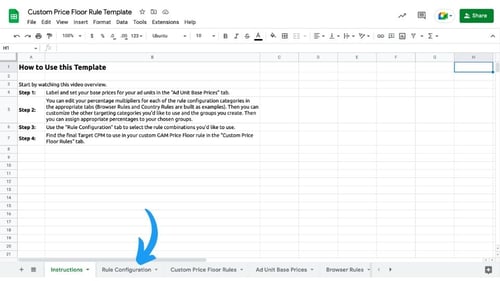
Here you’ll select which combinations of your targeting criteria you want to put together to create a custom pricing rule.
Start by selecting a name for your rule. It is easiest to match this exactly to the way you’ll name the rule in Google Ad Manager, so you can easily track which rules to change in the future if you want to adjust them.
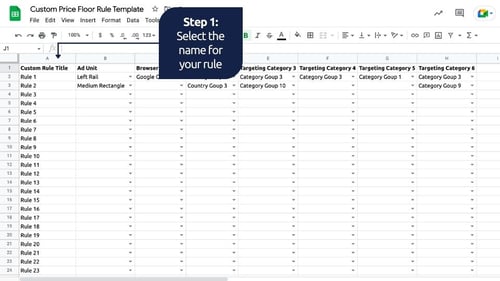
Next, select the ad unit you want to apply the rule to. The dropdown option will automatically pre-fill with all of the ad units you labeled in the “Ad Unit Base Prices” tab.
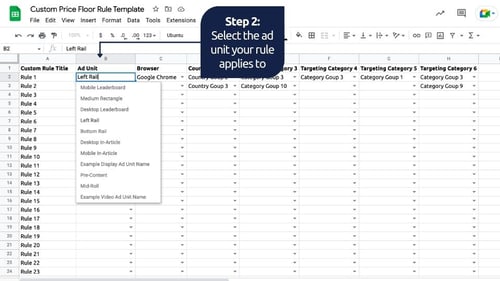
Then you’ll select your criteria triggers you want applied to the rule. The dropdown options will automatically pre-fill with all of the criteria grouping titles you filled out in the appropriate rule management tabs.
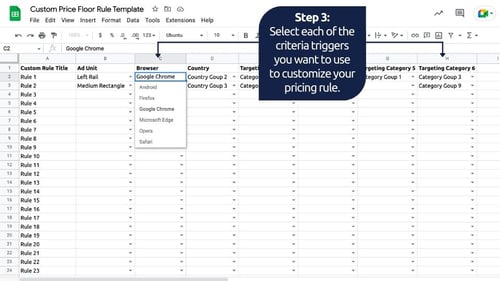
It is ok to leave one of the criteria targeting cells blank if you don’t want it incorporated into your custom rule. Say for instance you want to create a rule that doesn’t include a browser as one of the criteria breakdowns. You can simply leave it blank.
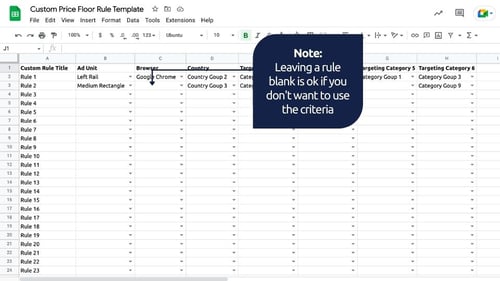
The template has space for 200 different custom price rules. As you know from before, and can easily see from all of the criteria you entered, there will be no way to create custom pricing rules for every combination of every factor (unless you work with a partner like Playwire), so be strategic in the rules you create.
Grab Your Automatically Generated Price Floors
Once you’re done configuring your rules, you’ll jump to the “Custom Price Floor Rules” tab.
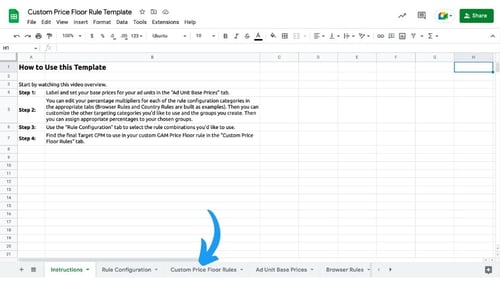
Here you will find your price floor rules automatically generated for you:
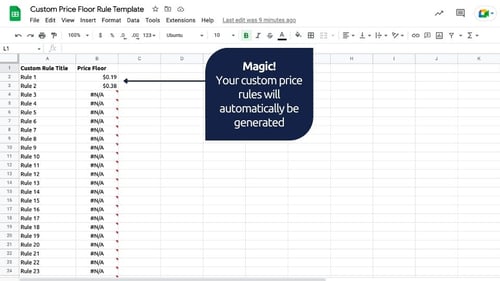
The Rule Title will automatically update to match the rule titles you created in the “Rule Configuration” tab and the Price Floors to accompany all of the criteria you selected will be automatically calculated in the “Price Floor” column.
Enter Unified Pricing Rules in Google Ad Manager
Now you just have to enter your rules in Google Ad Manager. Follow these steps to create a unified pricing rule in GAM.
Name your rule to match the name in the template. Match your target criteria selections to the target criteria you selected in the“Rule Configuration” tab, and then set the price floor to the calculated price floor in the “Custom Price Floor Rules” tab.
What Can You Do Now?
What Can You Do Now that You Have a Comprehensive Target CPM and Price Floor Strategy?
So what is the benefit to having a comprehensive price floor strategy like this?
Cohesive Strategy vs. Disjointed Strategy
Managing your strategy this way means the factors that influence multiple rules are managed from a single location. This allows you to combine your different influencing factors in a way you may never have thought of in the past.
When looking at rules as singular items, it is very difficult to determine what each factor combination might be worth to you. Looking at a user on a desktop device, browsing with Chrome on a Monday Afternoon seemed overly specific before, and deciding what that impression should be worth is nearly impossible.
This strategy allows you to combine your knowledge about how each of the unique targeting factors affect your CPMs together to create highly custom rules. Because you know individually what a desktop device, Chrome Browser, and Monday Afternoon view mean to you in terms of value, you can now put all that knowledge together to determine the value of the combination.
Streamlined Yield Experimentation
Managing your strategy this way also makes it much easier to run tests and experiments that might affect more than one rule at a time.
For instance, if you wanted to test increasing the target CPM incrementally for a single ad unit, you can update your ad unit base price rules, and it will automatically update all your price floor numbers for every rule that incorporates that ad unit.
Similarly, if you want to test increasing CPMs for a particular country group or browser, you can update the percentage assigned to that item in the appropriate rule tab and it will automatically update all your pricing rules that use that trigger criteria.
The Easy Button
Looking for the easy way out? We don’t blame you.
Luckily we’ve built a platform that automatically adjusts price floors across tens of thousands of trigger criteria combinations for you. Not to mention the fact that our AI and machine learning algorithms customize those triggers to your website automatically.
Save yourself countless hours in recurring efforts to manage price floors, months of testing to determine which changes in trigger criteria can provide you the greatest gains in revenue, and remove the limitations on the number of different price rule combinations you can have running at any given time.
Apply now to learn more about the revenue you could be earning.
AMPLIFY YOUR AD REVENUE
Accelerate your business and uncomplicate your ad tech stack, because you deserve a partner and a platform that demands more for you.